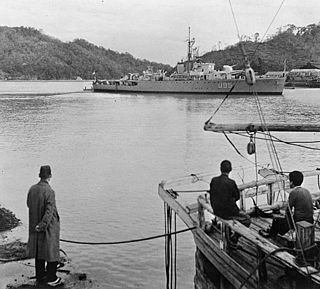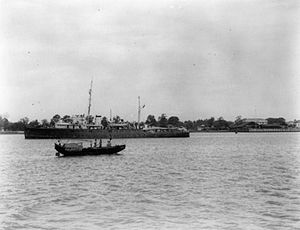
During the Second World War (1939–1945), India, Pakistan and Bangladesh were a part of the British Empire. British India officially declared war on Nazi Germany in September 1939. India, as a part of the Allied Nations, sent over two and a half million soldiers to fight under British command against the Axis powers. India also provided the base for American operations in support of China in the China Burma India Theater.

The Royal Indian Navy (RIN) was the naval force of British India and the Dominion of India. Along with the Presidency armies, later the Indian Army, and from 1932 the Royal Indian Air Force, it was one of the Armed Forces of British India.

Maritime powers in the Indian subcontinent have possessed navies for many centuries. Indian dynasties such as the Cholas used naval power to extend their influence overseas, particularly to Southeast Asia. The Marakkar Navy under Zamorins during 15th century and the Maratha Navy of the 17th and 18th centuries fought with rival Indian powers and European trading companies. The East India Company organised its own navy, which came to be as the Bombay Marine. With the establishment of the British Raj after the Indian Rebellion of 1857, the small navy was transformed into "His Majesty's Indian Navy", then "Her Majesty's Indian Marine", and finally the "Royal Indian Marine".

HMS Tenedos was an Admiralty 'S' class destroyer. Laid down on 6 December 1917, she was constructed by Hawthorn Leslie of Tyne, and was completed in 1918. She was commissioned in 1919 and served throughout the interwar period.

The Grimsby-class sloops were a class of 13 sloops-of-war laid down between 1933 and 1940. Of these, eight were built in the United Kingdom for the Royal Navy, four in Australia for the Royal Australian Navy and one for the Royal Indian Navy. Main armament was initially two 4.7-inch (120 mm) guns for RN ships and three 4-inch (100 mm) for Australian ships, but armament varied considerably between ships, and was increased later.

HMS Aberdeen was a Grimsby-class sloop in the British Royal Navy. Built in Devonport Dockyard, Plymouth, UK by Thornycroft, she was launched on 22 January 1936.

The Hastings class, also known as the Folkestone class, was a class of sloop which were built for the Royal Navy and the Royal Indian Navy in the interwar period. In total five ships were built, and went on to see service in the Second World War.

HMIS Godavari was a Black Swan-class sloop which served in the Royal Indian Navy (RIN) during World War II.

HMIS Narbada (U40) was a Modified Bittern class sloop, later known as the Black Swan class, which served in the Royal Indian Navy (RIN) during World War II.

HMIS Sutlej (U95) was a modified Bittern-class sloop, later known as the Black Swan class, which served in the Royal Indian Navy (RIN) during World War II.
HMIS Kistna (U46) was a Black Swan-class sloop which served in the Royal Indian Navy (RIN) during World War II.
HMIS Cauvery, pennant number U10, was a Black Swan-class sloop which served in the Royal Indian Navy (RIN) during World War II.
HMIS Jumna (U21) was a Black Swan-class sloop, which served in the Royal Indian Navy (RIN) during World War II.

HMIS Hindustan (L80) was a Folkestone-class sloop which served in the Royal Indian Navy (RIN) during World War II. Her pennant number was changed to U80 in 1940.

Admiral Adhar Kumar Chatterji was an Admiral in the Indian Navy. He served as the 6th Chief of the Naval Staff, from 4 March 1966, until 28 February 1970. He was the first Indian officer of the navy to hold the rank of full Admiral. He is credited with the transformation of the Indian Navy. He made sweeping changes and restructured the navy, creating the Western and Eastern Naval Commands and the Western Fleet. Under him, the Indian Navy also entered the submarine age, with the commissioning of INS Kalvari (S23) in 1967.

Vice Admiral Nilakanta Krishnan, PVSM, DSC, was a former flag officer in the Indian Navy. He was the Flag Officer Commanding-in-Chief Eastern Naval Command during the 1971 Indo-Pakistani War.

HMS Grimsby was a sloop of the British Royal Navy, the lead ship of her class. Grimsby was built in the 1930s, entering service in 1934. Serving most of her pre-war service at Hong Kong, Grimsby was deployed on convoy escort duties along the East coast of the Britain and in the Mediterranean Sea during the Second World War, and was sunk by dive bombers off Tobruk on 25 May 1941.
Rear Admiral Sadashiv Ganesh Karmarkar, MBE was a flag officer in the Indian Navy. He was the first Indian officer to command a ship of the Royal Indian Navy. During World War II, he commanded the auxiliary patrol vessel HMIS Ratnagiri, for which he was awarded the Member of the Order of the British Empire (MBE). He later became the first Indian to command British officers, when he commanded the sloop HMIS Kistna. He last served as the Flag Officer Bombay, from 1960 to 1964, before retiring.
Commodore Martin Henry St. Leger Nott, DSO, OBE was an Officer in the Royal Indian Navy. He was the first Chief of Staff to the Commander-in-Chief, Royal Indian Navy after the Independence of India. He died in a plane crash with his family at Mont Cardo, near Corsica, France, at the age of 43.















